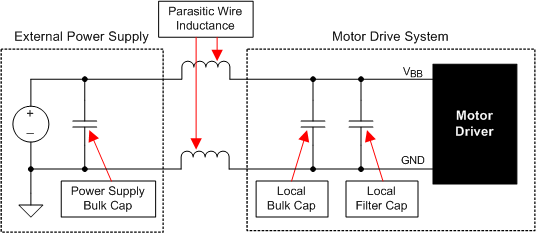SLVSC79D June 2014 – November 2020 DRV8801A-Q1
PRODUCTION DATA
- 1 Features
- 2 Applications
- 3 Description
- 4 Revision History
- 5 Pin Configuration and Functions
- 6 Specifications
-
7 Detailed Description
- 7.1 Overview
- 7.2 Functional Block Diagram
- 7.3 Feature Description
- 7.4 Device Functional Modes
- 8 Application and Implementation
- 9 Power Supply Recommendations
- 10Layout
- 11Device and Documentation Support
- 12Mechanical, Packaging, And Orderable Information
Package Options
Mechanical Data (Package|Pins)
- RMJ|16
Thermal pad, mechanical data (Package|Pins)
- RMJ|16
Orderable Information
9.1 Bulk Capacitance
Bulk capacitance sizing is an important factor in motor drive system design. This sizing is dependent on a variety of factors including:
- Type of power supply
- Acceptable supply voltage ripple
- Parasitic inductance in the power supply wiring
- Type of motor (brushed DC, brushless DC, stepper)
- Motor startup current
- Motor braking method
The inductance between the power supply and motor drive system will limit the rate current can change from the power supply. If the local bulk capacitance is too small, the system will respond to excessive current demands or dumps from the motor with a change in voltage. Size the bulk capacitance to meet acceptable voltage ripple levels.
The data sheet generally provides a recommended value but system-level testing is required to determine the appropriate sized bulk capacitor.
 Figure 9-1 Bulk Capacitance
Figure 9-1 Bulk Capacitance